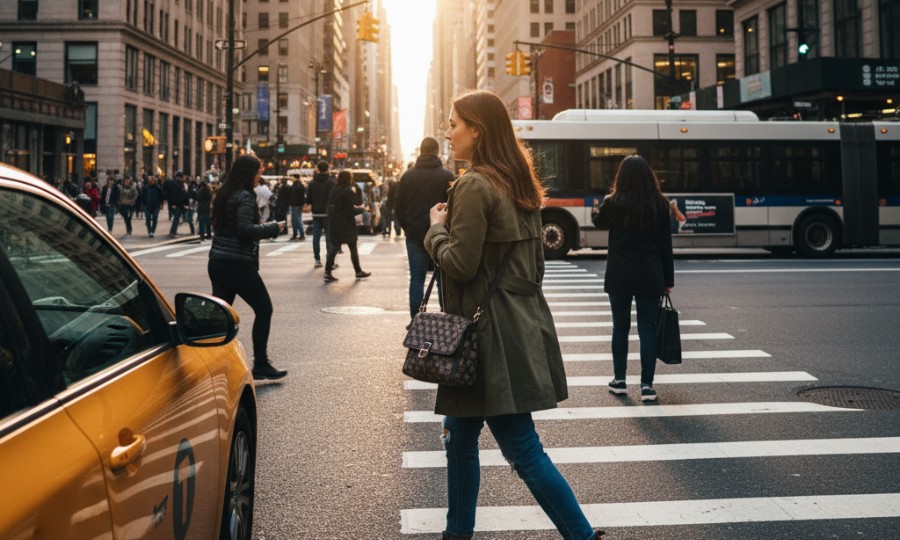
Ever found yourself on a bustling New York City street, wondering who really has the right-of-way? It’s a common dilemma, isn’t it? Whether you’re behind the wheel navigating gridlock or hustling across a busy intersection, understanding NYC’s pedestrian right-of-way laws isn’t just about avoiding a ticket; it’s about staying safe and keeping others safe too. We’re going to demystify these often-confusing rules, from the painted lines of a crosswalk to those invisible, yet legally binding, unmarked intersections.
The Foundation: Understanding NYC’s Right-of-Way Basics
Let’s get straight to it: the bedrock of pedestrian safety in New York City lies in understanding the Vehicle and Traffic Law. This isn’t just a suggestion; it’s the law. Generally speaking, pedestrians have the right-of-way in crosswalks, both marked and unmarked, when they are crossing with the signal or have lawfully entered the roadway. But what does ‘lawfully entered’ truly mean? It’s a critical distinction, especially in a city where every block can feel like a maze.
A marked crosswalk, with its clear white lines, seems straightforward enough, right? Yet, even there, drivers can sometimes be in a hurry, and pedestrians can be distracted. Here’s the thing: in New York, a driver must yield the right-of-way to a pedestrian crossing within a crosswalk. This applies even if the light changes while the pedestrian is still in the crosswalk – they don’t magically lose their right-of-way mid-crossing.
And for those unmarked intersections, you know, the ones at every corner without painted lines? The law treats them as if they are marked crosswalks. That’s right, every intersection implies a crosswalk, even if it’s not painted. So, as a driver, you’re expected to anticipate and yield to pedestrians who are reasonably attempting to cross within that implied space. It’s a significant responsibility, and one that often catches new drivers, or even seasoned ones, off guard. This fundamental principle is designed to protect our most vulnerable road users, and it’s a cornerstone of the city’s broader Vision Zero initiative, which aims to eliminate traffic fatalities and serious injuries.
Drivers, Your Crucial Role: What the Law Demands
As a driver in New York City, your responsibility at intersections and crosswalks is paramount. The law is quite clear: you must exercise due care to avoid colliding with any pedestrian. This isn’t just about seeing them; it’s about actively preventing an accident. Think about it: if you’re making a turn, whether left or right, you’re required to yield to pedestrians who are crossing the roadway you’re entering. It doesn’t matter if they’re still on the curb waiting or already halfway across; if they’re lawfully in the crosswalk, they’ve got the green light, so to speak.
We’ve all seen those moments where a driver tries to ‘beat’ a pedestrian, haven’t we? It’s not just aggressive; it’s illegal and incredibly dangerous. Under New York State Vehicle and Traffic Law Section 1146, drivers making a left turn must yield to any vehicle or pedestrian approaching from the opposite direction which is within the intersection or so close as to constitute an immediate hazard. This extends to pedestrians crossing your path. What if a pedestrian is jaywalking? Even then, the law requires drivers to exercise ‘due care’ to avoid hitting them. While a pedestrian might be at fault for jaywalking, a driver isn’t absolved of all responsibility to avoid a collision. It’s a nuanced point, but it underscores the very high standard of care expected from drivers in our bustling city. Are you always looking for pedestrians, especially at those tricky, high-volume intersections? You really should be, because their lives literally depend on it. This focus on driver accountability is a key pillar of NYC’s traffic safety strategy, continuously reinforced through campaigns by the NYC Department of Transportation (DOT).
Pedestrians, Know Your Rights (and Responsibilities!)
Now, let’s talk about you, the pedestrian. While the law grants you significant protections, it doesn’t give you a free pass to ignore common sense or traffic signals. You’ve got rights, yes, but you also have responsibilities. For instance, you shouldn’t suddenly leave a curb or other place of safety and walk or run into the path of a vehicle that’s so close it’s impossible for the driver to yield. That’s just asking for trouble, and frankly, it’s not how the law works.
When traffic signals are present, you must obey them. A ‘Walk’ signal means you can proceed, but a ‘Don’t Walk’ or flashing ‘Don’t Walk’ means you should stay on the curb. Trying to squeeze in a crossing against a flashing signal might seem like a quick shortcut, but it puts you directly in harm’s way and violates the law. (And let’s be honest, who hasn’t been tempted to sprint across a street when the light’s about to change?) What’s more, if you’re crossing at a point where there’s no marked crosswalk and no traffic signal, you’re generally expected to yield to all vehicles on the roadway. This is where ‘jaywalking’ comes in. While not always a ticketable offense in itself across all of NYC (it depends on specific circumstances and local ordinances), it certainly compromises your legal standing if an accident occurs. So, while drivers carry a heavy burden of care, pedestrians aren’t entirely off the hook. Staying alert, avoiding distractions like cell phones, and making eye contact with drivers are simple yet incredibly effective ways to protect yourself. Remember, those legal protections are strongest when you’re following the rules yourself. It’s a two-way street, literally.
Legislative Shifts: How NYC is Adapting for Safety
New York City is constantly evolving its approach to street safety, often in response to tragic incidents and a commitment to Vision Zero. One significant shift over the past decade has been the increased focus on driver accountability and the expansion of pedestrian protections. For example, recent legislative changes have reinforced that drivers who fail to yield to pedestrians in crosswalks, resulting in injury or death, can face more severe penalties. This isn’t just a slap on the wrist; it’s a serious acknowledgment of the devastating impact these collisions have on families and communities.
The city has also implemented lower speed limits on many streets (25 mph in most areas, unless otherwise posted), creating a safer environment for everyone. Think about how much more reaction time a driver has at 25 mph versus 30 or 35 mph – it’s a significant difference that can literally save a life. Beyond that, there’s been a push for better street design, including leading pedestrian intervals (where pedestrians get a ‘Walk’ signal a few seconds before vehicles get a green light) and expanded pedestrian plazas. These infrastructure changes aren’t just cosmetic; they’re strategically designed to reduce conflicts between vehicles and pedestrians. For instance, imagine a busy intersection like 34th Street and 7th Avenue near Penn Station. The sheer volume of foot traffic demands every possible safety measure. The implementation of leading pedestrian intervals there has demonstrably reduced pedestrian-vehicle conflicts by giving walkers a head start, making their presence clear before drivers even begin to move. It’s a proactive approach that recognizes the inherent vulnerabilities of pedestrians in a dense urban environment. We’re talking about a city that’s genuinely trying to build safety into its very fabric, not just enforce it after the fact.
Navigating Complex Scenarios: Tips for Everyone
So, how do we all navigate these complex NYC streets safely, day in and day out? It really boils down to vigilance and respect. For drivers, that means eliminating distractions – put the phone away, skip that last sip of coffee until you’re parked. Be extra cautious when turning, always assuming a pedestrian might be in the crosswalk. And remember, a flashing yellow light at an intersection means proceed with caution, yielding to pedestrians and other traffic. For pedestrians, it’s about being seen and being predictable. Wear bright clothing if you’re out at night. Make eye contact with drivers before stepping into a crosswalk, even if you have the right-of-way. (After all, a driver might be distracted, or simply not see you.) Don’t assume that just because you’re legally in the right, you’re immune to harm. We’ve all seen pedestrians glued to their phones, oblivious to their surroundings. Is that really worth risking your life for? It’s not. For example, consider a scenario near a school zone during dismissal. Drivers must be hyper-aware of children who might dart out. Pedestrians, especially parents with children, should use marked crosswalks and teach kids to look both ways, even when the walk signal is on. It’s about shared responsibility, even with the legal burden leaning heavily on drivers. Ultimately, mutual awareness is our best defense. We know this feels overwhelming sometimes, given the constant rush of city life, but a moment of attention can prevent a lifetime of regret. Let’s all do our part to make NYC’s streets safer for everyone.
Navigating New York City’s right-of-way laws can seem daunting, but armed with this knowledge, you’re better equipped to move through the city safely and confidently. Whether you’re driving a taxi, riding a bike, or simply walking to work, understanding these rules protects not just you, but everyone sharing our vibrant streets. Let’s commit to being more aware, more patient, and more responsible. Your next journey through NYC starts with knowing the law. Stay safe out there!
Free Case Consultation
Injured in an accident? Contact Rosenberg, Minc, Falkoff & Wolff for a free and confidential case review with an experienced NYC personal injury attorney.


